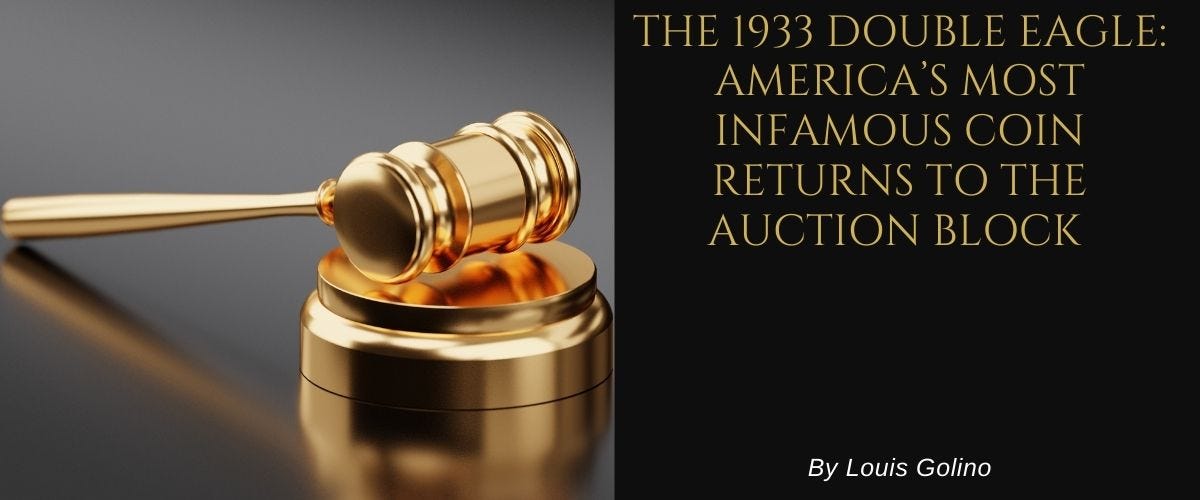Local Storage seems to be disabled in your browser.
For the best experience on our site, be sure to turn on Local Storage in your browser.
The 1933 Double Eagle: America’s Most Infamous Coin Returns to the Auction Block

By Louis Golino
For the past two decades, the collector's identity who purchased the only 1933 gold double eagle that is legal to own privately remained a mystery. On March 10, 2021, his identity was finally revealed in an article in the New York Times, shoe designer and philanthropist Stuart Weitzman.
In a 2002 auction, the coin sold for $6.5 million-plus a 15% buyer's fee, bringing the total to $7,590,000 – a world record price for a coin at that time. $20 was added to the price to monetize it, and the U.S. Mint issued a monetization certificate. Since then, that 1933 Double Eagle has been exhibited either in New York at the Federal Reserve Bank in Manhattan or other locations.
The New York Times article also stated that Weitzman plans to have the notorious coin sold at an auction to be conducted June 8, 2021, by Sotheby's, along with two scarce stamp items – the unique 1856 one-cent Magenta from British Guiana and a plate block of four Inverted Jenny stamps. Proceeds from the sale of these multi-million-dollar rarities will go towards several charitable organizations, including the Weitzman Family Foundation, the Weitzman School of Design at the University of Pennsylvania, and a museum in Madrid, Spain.
The news about the 1933 double eagle has given numismatics some helpful publicity in the mainstream press. The sale may inject even greater interest in this beloved coin series whose design by Augustus Saint-Gaudens of Liberty striding forward on the obverse and an American eagle in flight on the reverse is almost universally viewed as America's most beautiful numismatic motif. In fact, the obverse design, is still in use on modern Gold Eagles today!
Why is the 1933 Double Eagle So Infamous?
On the one hand, the 19933 Double is far from the lowest mintage American coin. Several other pieces like the unique 1870-S $3 gold coin exist in much lower numbers, as are several other coins that are mostly either in museums or private collections. Furthermore, unlike the 1913 Liberty nickel, which was never supposed to have been issued, 445,500 1933 double eagle were struck in 1933 – the last year in which gold coins were made for circulation.
- While 445,500 Double Eagles were minted, none ever circulated, and all but two were supposed to have been melted down. A small quantity were later discovered to have left the Mint.
- According to the U.S. government all but one 1933 Double Eagle remain the property of the government - the one Weitzmen bought in 2002 that is being auctioned in June 2021.
- The Double Eagle was designed by famous numismatic designer Augustus Saint Gaudens.
- In the 1940s The Secret Service investigated coins that seemingly left the mint and traded in the 1930s and 40s, declaring them stolen.
- King Farouk of Egypt, an avid coin collector managed to get his hand on a 1933 Double Eagle.
- The Weitzmen Double Eagle going up for auction in June was stored at the World Trade Center for five years of legal battles, but was moved in early 2001!
- In 2002 the only legal to own 1933 Double Eagle sold for a total of $7,590,000 dollars, and is going up for auction again in June 2021.
Why is the 1933 Double Eagle illegal?
The 1933 double eagle is a coin that is not supposed to trade in the market. None of those coins were ever authorized for use, and almost all of them were melted a couple of years after they were made. This melting occurred because after they were struck, the new U.S. President Franklin Delano Roosevelt -- in one of his first significant actions -- forbade payment in gold and the hoarding or exportation of gold coins or bullion on March 6, 1933. Then on April 8 that same year, he issued his famous Executive Order 6102, which "forbade the hoarding of gold coin, gold bullion, and gold certificates within the continental United States by individuals, partnerships, associations, and corporations."
On August 4, 1934, following the passage of the Gold Reserve Act of 1934, U.S. Mint Director Nellie Tayloe Ross gave the order for all branches of the U.S. Mint to begin melting down all gold coins those mints had on hand. However, two weeks later, two of the 1933 coins were transferred by Ross' order to the Smithsonian, where to this day they are a significant highlight of the National Numismatic Collection.
Between February and June 1937, almost half a million gold double eagles from 1933 were melted down, yet some coins somehow left the Mint. Most of them are believed to have done so through an alleged collaboration between Mint cashier George McCann and Philadelphia jeweler Israel Switt.
To this day, the U.S. government continues to maintain that all 1933 gold double eagles remain the property of the government and are subject to confiscation except for one coin – the one that Weitzman purchased in 2002 in an unusual legal settlement.
The other examples of the coin, including about 20 that openly traded in the 1930s and 1940s, were later almost all seized by the government or voluntarily surrendered and melted down. A 1944 Secret Service investigation found that all those coins should not have left the Mint and were considered stolen.
In 2004, the heirs of Israel Switt discovered another hoard of 20 coins in a safety deposit box that was later seized by the government and stored at Fort Knox. The family went through 11 years of litigation to keep the coin that reached the Supreme Court, but in the end, judges ruled that they too were government property.
In 2018 another example of the coin was voluntarily surrendered by an anonymous collector.
Mehl-Farouk-Fenton coin
Most experts believe the coin sold in 2002 that will again be sold this June is the one that famous Texas dealer B. Max Mehl bought from Switt in the 1930s that was then sold to a representative of King Farouk of Egypt on February 23, 1944.
Farouk was an avid collector of coins and other items who was deposed in a 1952 military coup. The 1933 coin had been incorrectly granted an export license by the State Department to leave the country, probably because of the Egyptian leader's friendship with Roosevelt. The government tried to stop it from leaving the country at the last minute, but it was already gone.
Many of Farouk's coins were sold in a 1954 Sotheby's auction in Cairo, Egypt, but when the U.S. government learned his 1933 double eagle was part of the sale, the coin was withdrawn and then disappeared for decades.
In 1995 a coin believed to be the same one surfaced when an Egyptian jeweler was selling unsold lots from the 1954 auction to a director at Spink's in London named Andre de Clermont and his partner Stephen Fenton who purchased the famous coin for $325,000.
When Fenton tried to sell it in 1996, the coin was seized by the U.S. Secret Service in a sting operation that has been the subject of many television recreations. This seizure was followed by five years of litigation that led the government to opt not to arrest Fenton and eventually to a 2001 legal settlement. He and the U.S. government would split the proceeds from the sale of the coin at an auction. That happened on July 30, 2002, at Sotheby's when it had an estimated value of $4-6 million, which it surpassed, reaching $6.5 million or $7,590,020 with a seller's fee.
After reimbursing Sotheby's for its services and deducting the U.S. Mint's expenses to protect the coin, the remaining slightly more than $3 million that went to the U.S. government was later transferred to the Treasury.
Another exciting aspect of this story is that the coin was stored during the five years of legal battles at the Secret Service office in the World Trade Center. In 2001 after the settlement, the coin was transferred to Fort Knox. Had it not been moved, it most likely would have perished in the 9/11 attacks!
1933 Double Eagle June 2021 Sotheby Auction Sales Estimates
It is difficult to predict what the coin will sell for in June 2021. Sotheby's estimate is $10-15 million, but the top end of that range could be a bit too optimistic given that there are 12 known examples in government hands.
The grade is another issue. The Weitzman coin, which is raw, has been estimated to grade Mint State 65 condition, while the Swiss hoard seized in 2004 included two in that grade, six in Mint State 64 condition, one in uncirculated details condition, and one graded finer in Mint State 66 condition.
Price guides typically use the 2002 sale price to value the coin. Still, in 2011 Steve Roach argued that if those coins from Switt were ever auctioned, they would bring a minimum of $2 million each depending on whether they were sold at the same time, which tends to depress values, or overtime, which should mean higher values.
A final factor to consider is that the coin being sold in June is likely to remain the only one collectors can legally purchase and own, which means the existence of those other 12 coins and a couple of others that are illegal that may be out there, should not impact the price.
Considering that several other famous rare coins have sold in recent years in the $9-10 million range, that would seem to be a fair low-end estimate for the 1933 double eagle. Those other coins are mostly rarer in surviving examples, yet no other coin has been the subject of almost 90 years of intrigue and controversy as the 1933 double eagle.
Whatever price the coin fetches, the auction is sure to captivate the numismatic world.
Sources:
Paul Gilkes, “1933 gold $20 auction is set,” Coin World, March 29, 2021
Charles Morgan and Hubert Walker, “United States 1933 Double eagle $20 Gold coin,” www.coinweek.com, February 26. 2021
Christopher Bulfinch, “1933 Double Eagle to be Auctioned by Sotheby’s,” www.coinweek.com, March 11, 2021
Steve Roach, “Pricing the Priceless: What’s a 1933 $20 Gold Double Eagle Worth?”, Coin World, July 8, 2011
© 2024 Copyright GovMint.com. All Rights Reserved. GovMint.com does not sell coins and numismatics as investments, but rather as collectibles. Please review GovMint's Terms and Conditions, Terms of Use and Privacy Policy before using this website and prior to purchasing from GovMint.com.




